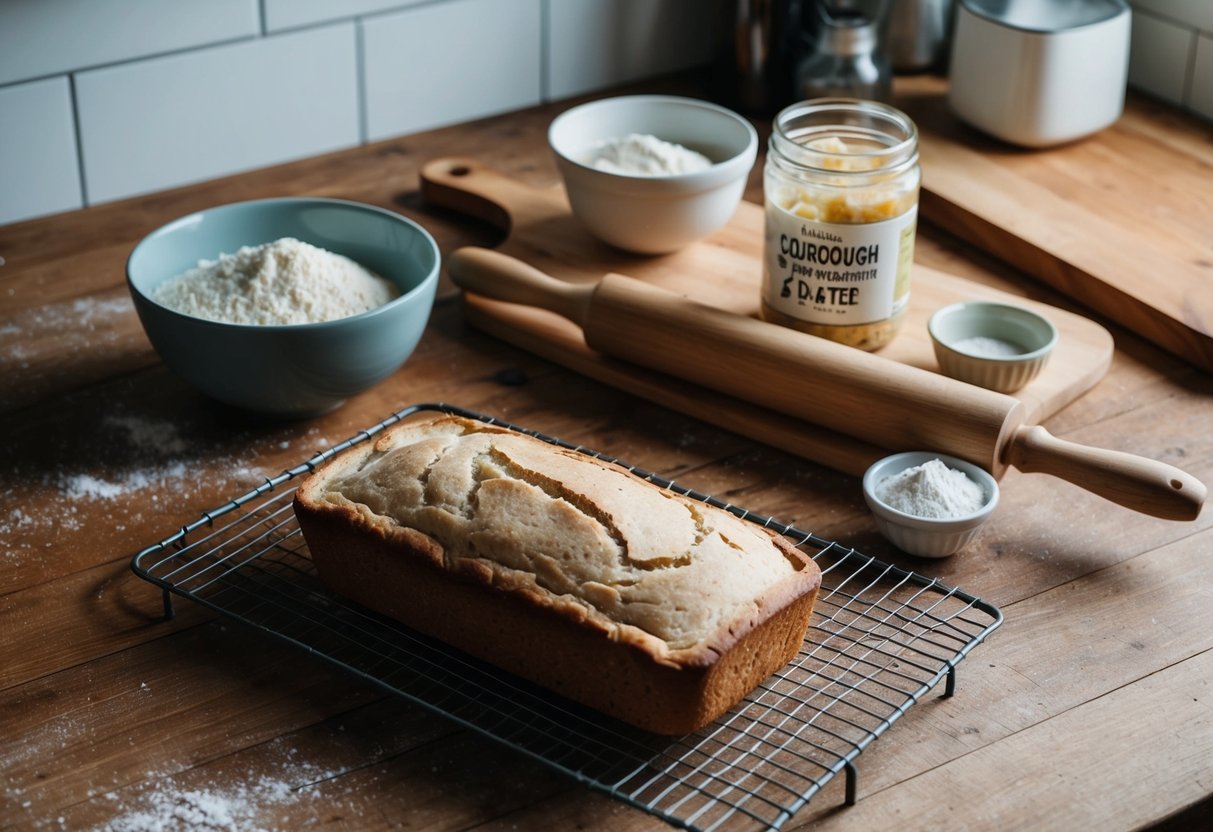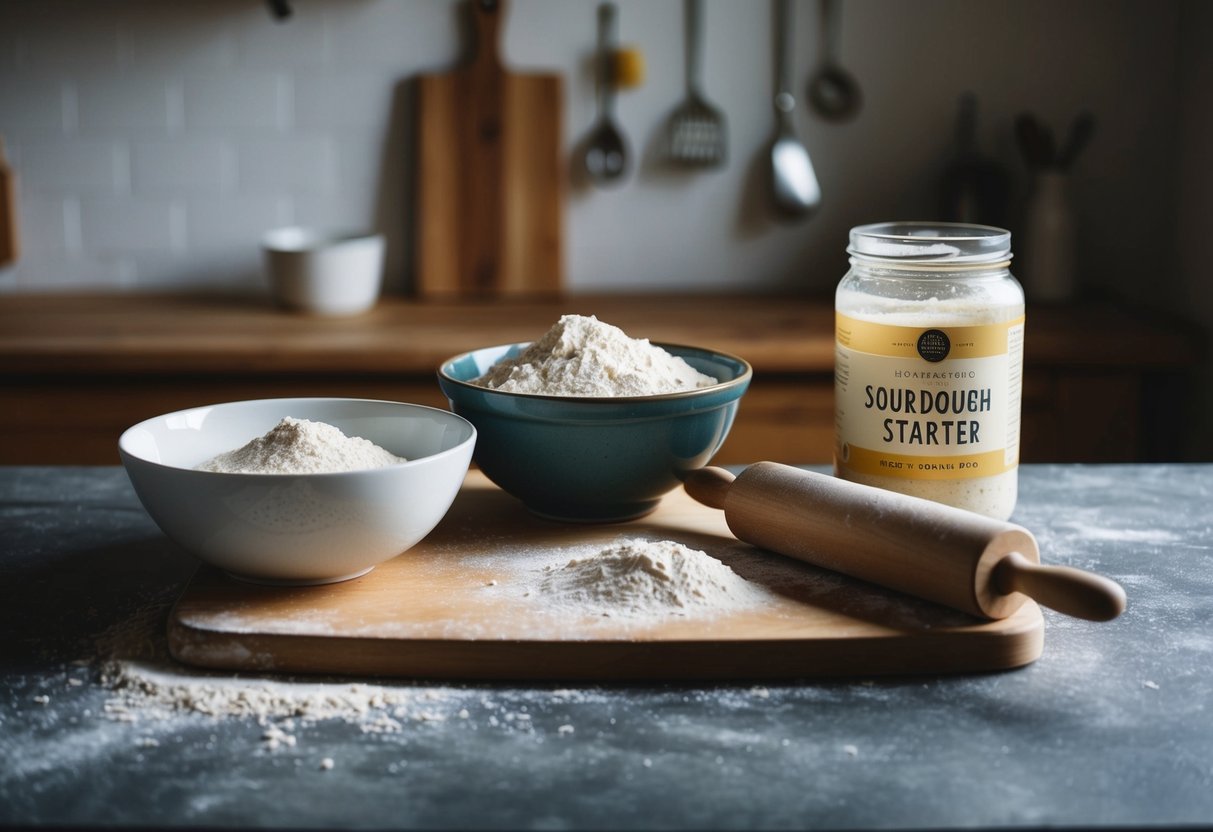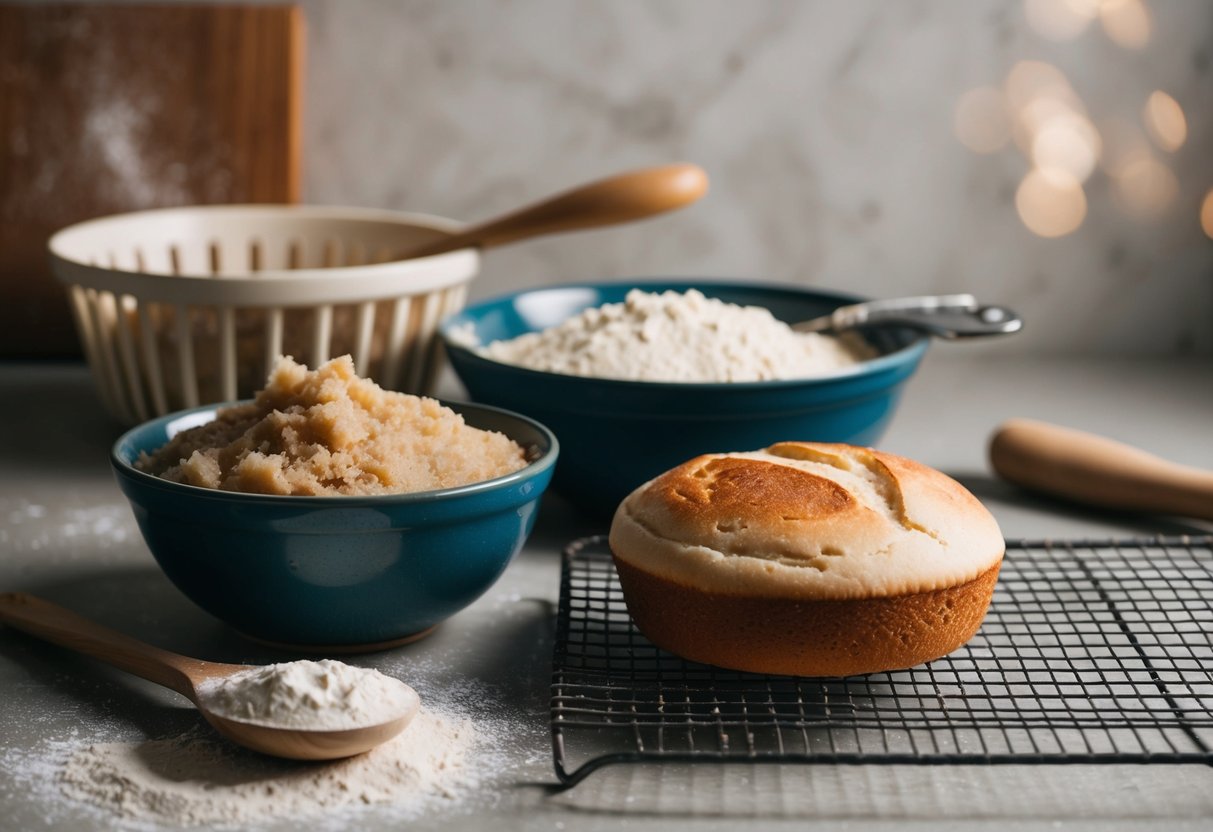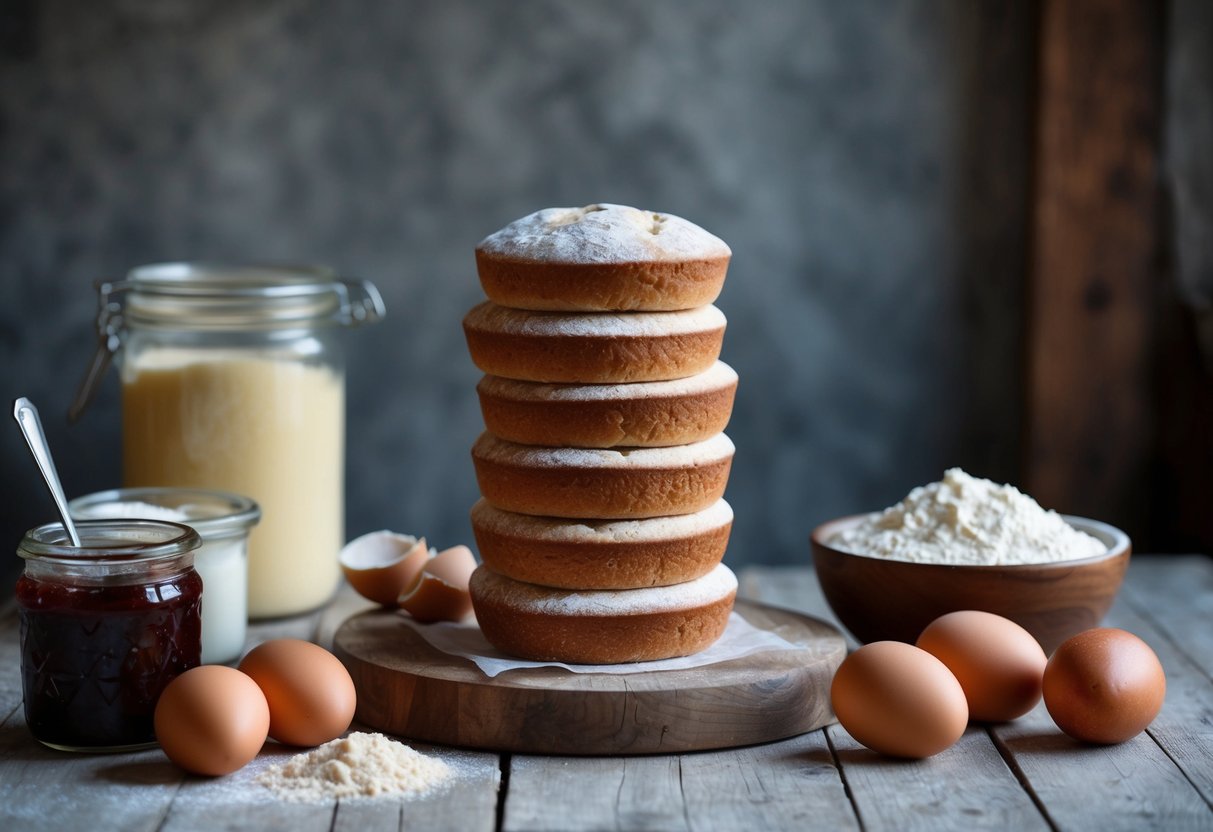==================
Affiliate Statement
Best Baking Tips is supported by our audience. When you purchase through one of our links, we may earn a small affiliate commission. As an Amazon Associate I earn from qualifying purchases. Your cost is not affected.
==================
Looking to level up your breakfast game? Say hello to Sourdough English Muffin Bread—a cozy, homemade twist on a classic favorite! With its soft, chewy texture and those irresistible nooks and crannies, this bread is perfect for toasting, slathering with butter, or layering with your favorite spreads. Whether you’re a sourdough fan or just love a good, hearty breakfast, this recipe brings warmth and comfort to your mornings in the most delicious way. Excited to try? Let’s get baking!
Sourdough English Muffin Bread: A Cozy Twist on Breakfast Classics
Have you ever wanted to make English muffins at home but found the process too time-consuming? I’ve got great news for you! Sourdough English muffin bread is the perfect solution. It combines the tangy flavor of sourdough with the nooks and crannies we love in English muffins, all in an easy-to-make loaf form.

This bread gives you the taste and texture of English muffins without the hassle of shaping individual rounds. I love how simple it is to whip up a batch. All you need is a sourdough starter, some basic ingredients, and a loaf pan. The result is a crusty exterior and a soft, chewy interior that’s perfect for toasting.
I find this bread incredibly versatile. It’s great for breakfast, sandwiches, or as a side with soups and salads. Plus, making it at home allows you to control the ingredients and avoid preservatives often found in store-bought versions. Let’s dive into how you can make this delicious bread in your own kitchen!
Key Takeaways
- Sourdough English muffin bread combines the flavors of sourdough and English muffins in an easy loaf form
- The bread requires basic ingredients and equipment, making it accessible for home bakers
- Homemade sourdough English muffin bread offers versatility in serving and allows control over ingredients
What is Sourdough English Muffin Bread?

Sourdough English muffin bread is a tasty mix of two beloved baked goods. It has the tangy flavor of sourdough and the texture of English muffins but in a loaf form.
The History of Sourdough
Sourdough has been around for thousands of years. Ancient Egyptians were among the first to use it. They found that leaving dough out led to a bubbly, fermented mix. This mix made bread rise without yeast. Settlers brought sourdough to America during the Gold Rush. They kept starters alive in harsh conditions.
I find it amazing how sourdough has stood the test of time. It’s still popular today, with many bakers keeping their own starters.
Defining English Muffin Bread
English muffin bread is a loaf that mimics the taste and texture of English muffins. It’s easier to make than individual muffins. The bread has a soft, spongy inside with lots of nooks and crannies. These holes are perfect for holding melted butter or jam.
I love how it toasts up crispy on the outside, perfect for breakfast or sandwiches. The loaf shape makes it simple to slice and enjoy.
Characteristics of Sourdough Bread
Sourdough bread is known for its distinct tangy flavor, which comes from the lactic acid produced in the starter. This same starter also gives sourdough its signature chewy texture and crispy crust. While sourdough takes longer to make, the wait is more than worth it. The slow fermentation process allows the natural yeast to work its magic, creating deep, rich flavors that quick-rise breads just can’t match.
Another bonus? Sourdough is often easier to digest than regular bread. The fermentation process helps break down some of the gluten, which is why many people with gluten sensitivities find they can still enjoy it. Plus, sourdough tends to stay fresh longer because its acidity helps fend off mold. All in all, sourdough is a delicious, healthier, and longer-lasting option for bread lovers!
Sourdough English Muffin Bread

English muffin bread has all the nooks and crannies that english muffins have, in an easy to bake loaf. Sourdough gives a healthy and tangy touch to this great recipe that has become a family favorite.
- 1/2 cup sourdough starter (make sure your starter is active)
- 1 cup water (lukewarm, about 110-115°F)
- 2 cups bread flour (or all-purpose flour; I use white wheat)
- 1 tbsp honey
- 1 tsp baking soda
- 1/2 tsp salt
- 1 tbsp Butter (for greasing pan, or use a silicone pan or parchment paper)
- Combine the sourdough starter, water, and flour in a bowl.
- Cover with a damp kitchen towel or cheese cloth. Allow it to rise in a warm area for 12 to 24 hours—it should double in size. Note: you can cause a slow rise in your refrigerator overnight.
- After the dough rises, mix in the honey, baking soda, and salt.
- Preheat the oven to 350F and grease a loaf pan.
- Shape the dough into a loaf and place it in the loaf pan.
- Bake for 45 to 50 minutes* until the top is browned and an inserted toothpick comes out clean!
- Remove from oven, allow to cool. Enjoy with butter and honey!
Notes
Ovens often bake at different times. I’ve noticed my friend’s gas oven bakes faster than my electric oven. Keep an eye on the TOP of the loaf—you want it brown, not burned!
Benefits of Sourdough Bread

Sourdough bread offers some great perks. I love how it packs a nutritional punch, helps my digestion, and stays fresh longer than regular bread. Let’s take a closer look at these benefits.
Nutritional Value
Sourdough bread is packed with good stuff for my body. It has more nutrients than regular bread, which is awesome. I get a nice dose of:
- Calcium
- Potassium
- Magnesium
- Folate
- Niacin
Plus, it’s full of antioxidants. These little helpers fight off the damage in my body. I also like that sourdough has less phytic acid than other breads. This means I can absorb more minerals from it. The fermentation process in sourdough creates lactic acid. This acid helps lower the bread’s glycemic index. For me, this means steadier blood sugar levels after eating.
Digestive Health
I find sourdough bread much gentler on my stomach compared to other types of bread. The long fermentation process breaks down a significant amount of gluten, making it easier to digest—a win for my gut!
This process also produces prebiotics, which feed the beneficial bacteria in my digestive system. Healthy gut bacteria mean a healthier, happier me.
For those with mild gluten sensitivity, sourdough can often be a better option since much of the gluten is broken down during fermentation. However, if I had celiac disease, I’d still need to steer clear of it, as it’s not completely gluten-free.
Longer Shelf Life
One of my favorite things about sourdough bread is how long it lasts compared to other breads. Thanks to the natural acidity from fermentation, it acts as its own preservative, meaning less food waste for me.
I can keep sourdough fresh on the counter for 4-5 days, and it can last up to a week in the fridge—perfect for when I don’t feel like making frequent grocery trips.
Even when it starts to go a bit stale, sourdough still has its charm. Older slices make fantastic toast or croutons, so nothing ever goes to waste! It’s a win for both my taste buds and my efforts to reduce waste.
Starting With the Basics

Making sourdough English muffin bread begins with a few key elements. I’ll cover the essential components and techniques to get you started on your baking journey.
Understanding Sourdough Starter
Sourdough starter is the heart of this bread. It’s a mix of flour and water that captures wild yeast and bacteria. I feed my starter daily with equal parts flour and water. This keeps it active and ready to use.
A healthy starter should double in size within 4-8 hours after feeding and it should have a bubbly texture and a slightly sour smell. I test my starter by dropping a small amount in water – if it floats, it’s ready to use.
For sourdough English muffin bread, I use about 1/2 cup of active starter per loaf. This gives the bread its unique flavor and texture.
Flour Types and Their Uses
The type of flour you use affects the bread’s texture and taste. I prefer a mix of flours for the best results.
- Bread flour: High protein content, creates a chewy texture
- All-purpose flour: Versatile, good for a softer crumb
- Whole wheat flour: Adds nutrition and a nutty flavor
I usually use a 3:1 ratio of bread flour to whole wheat flour. This gives a good balance of texture and flavor. For English muffin bread, I sometimes add cornmeal. It gives the crust a nice crunch and traditional flavor.
Water Temperature and Bread Texture
Water temperature also plays a big role in bread texture. I use warm water, around 90-95°F (32-35°C) which helps activate the yeast in the starter. Cold water slows down fermentation, resulting in a denser loaf. Hot water can kill the yeast, preventing proper rise.
I always measure water temperature with a thermometer. This ensures consistent results every time.
The amount of water also matters. More water creates a softer, more open crumb. Less water results in a denser loaf. For English muffin bread, I aim for a wetter dough to get those classic nooks and crannies.
Making the Bread
I absolutely love baking sourdough English muffin bread! The process is not only fun but also rewarding, resulting in a perfectly tangy loaf with a soft, airy interior and a crispy, golden crust. It’s a great twist on a classic favorite, and I’m excited to share the key steps so you can easily create this delicious bread at home.
Creating the Dough
To start, I mix my active sourdough starter with flour, water, and a touch of honey. I use a stand mixer with a dough hook to combine everything until it forms a sticky dough. Then, I cover the bowl and let it rest for about 30 minutes. This step, called autolyse, helps develop gluten.
Next, I add salt and knead the dough for 5-7 minutes until it becomes smooth and elastic. The dough should be tacky but not overly sticky. If needed, I adjust the consistency by adding a bit more flour or water.
I shape the dough into a ball and place it in a lightly oiled bowl. Then, I cover it with a damp cloth for the first rise.
First Rise and Punch Down
During the first rise, I let the dough sit in a warm spot for 4-6 hours. This allows the yeast to work its magic, creating those signature sourdough flavors. After the dough has doubled in size, I gently punch it down to release the gas. This step helps redistribute the yeast and creates a more even crumb in the final loaf.
I then turn the dough out onto a lightly floured surface and give it a quick knead. This step helps to strengthen the gluten network even further.
Shaping the Dough
Now comes the fun part—shaping the dough! I gently form it into a loaf that fits perfectly into my greased 9×5-inch pan, making sure to create surface tension by tucking the edges underneath for a smooth, tight top.
Before placing the dough in the pan, I like to sprinkle a bit of cornmeal on the bottom. This adds a lovely texture to the crust, giving it that classic English muffin vibe with a bit of crunch in every bite. It’s a simple touch that really elevates the final result!
Second Rise and Scoring
For the second rise, I cover the loaf pan with a damp cloth and let it sit for another 2-3 hours. During this time, the dough should rise to just above the rim of the pan. Before baking, I score the top of the loaf with a sharp knife or bread lame. This allows for even expansion in the oven and creates that classic split-top look.
I preheat my oven to 425°F (220°C). Just before putting the loaf in, I spritz the top with water. This helps create steam, which contributes to a crispy crust. I bake the bread for about 25-30 minutes until it’s golden brown and sounds hollow when tapped on the bottom.
Baking Tools and Equipment

Making sourdough English muffin bread requires a few key tools and equipment. I’ll go over the essential items you’ll need to bake delicious loaves at home.
Choosing the Right Bakeware
For sourdough English muffin bread, I like to use a standard 9×5-inch loaf pan. This size works well for most recipes. I prefer metal pans over glass or ceramic, as they conduct heat better.
A good quality pan makes a big difference. Look for one that’s heavy-duty and non-stick. This helps the bread release easily after baking. Sometimes I use a Dutch oven instead of a loaf pan. It creates a nice crust on the bread. If you go this route, choose one that’s 4-5 quarts in size.
Essential Baking Tools
Beyond bakeware, I find a few other tools really helpful:
- Digital kitchen scale – for precise measurements
- Mixing bowls – large ones for mixing dough
- Dough scraper – to handle sticky dough
- Thermometer – to check water and bread temperature
- Bread lame – for scoring the dough before baking
I also use a stand mixer sometimes, but it’s not required. You can mix by hand if you prefer. Don’t forget oven mitts and cooling racks. These keep you safe and help your bread cool properly after baking.
Cooking Techniques
Making sourdough English muffin bread requires some specific techniques. I’ll share my tips for preheating, baking, checking doneness, and proper storage to help you get the best results.
Preheating and Baking
I always start by preheating my oven to 350°F (175°C). This temperature works well for most sourdough English muffin bread recipes. Before baking, I lightly grease a 9×5-inch loaf pan. Then, I sprinkle cornmeal on the bottom and sides. This prevents sticking and gives the bread that classic English muffin texture.
I shape the dough into a loaf and place it in the pan. Then I let it rise for about 30-60 minutes until it’s puffed up nicely. When ready, I pop the pan in the preheated oven. I bake for about 30-35 minutes. The exact time can vary, so I keep a close eye on it.
Checking for Doneness
Knowing when the bread is done is crucial. I look for a few key signs:
- Golden brown crust
- Hollow sound when tapped on the bottom
- Internal temperature of 190°F-200°F (88°C-93°C)
I use a digital thermometer to check the internal temp. It’s the most reliable method I’ve found. If the top is browning too quickly, I cover it with foil. This prevents burning while allowing the inside to finish cooking.
Cooling and Storing
Once done, I remove the bread from the oven. I let it cool in the pan for about 5 minutes. Then, I carefully turn it out onto a wire rack. It’s important to let it cool completely before slicing. This can take 1-2 hours.
For storage, I wrap the cooled bread tightly in plastic wrap or place it in an airtight container. It stays fresh at room temperature for 2-3 days. If I want it to last longer, I slice and freeze it. This way, I can thaw and toast individual pieces as needed.
Serving and Pairings

Sourdough English muffin bread is versatile and delicious. I love how it can be enjoyed in many ways, from classic breakfast combos to creative meal ideas.
Classic Combinations
I always start my day with a slice of toasted sourdough English muffin bread. It’s perfect with a pat of butter melting into the nooks and crannies. For a heartier breakfast, I add a fried egg on top.
Sometimes I spread on some jam or honey for a sweet touch. Peanut butter is another favorite of mine – it fills me up and tastes great. When I want something savory, I make avocado toast. I mash ripe avocado onto the bread and sprinkle it with salt and pepper. Yum!
Creative Toppings
I like to get creative with my toppings. One of my go-to snacks is sourdough English muffin bread with hummus and sliced cucumbers. It’s refreshing and satisfying. For a pizza-inspired treat, I top a slice with tomato sauce, mozzarella, and herbs, then broil it until the cheese melts. It’s like a quick personal pizza!
Another tasty combo I enjoy is ricotta cheese with sliced figs and a drizzle of honey. The creamy, sweet, and tangy flavors work so well together. When I’m craving something indulgent, I make French toast using this bread. The sourdough flavor adds an extra dimension to the classic breakfast dish.

Bread as a Meal Component
I often use sourdough English muffin bread as part of a larger meal. It makes an excellent base for open-faced sandwiches. I top it with sliced turkey, cheese, and tomato, then broil it for a quick lunch.
For dinner, I serve it alongside soups and stews. The bread is perfect for soaking up flavorful broths. I also use it to make croutons for salads. I cube the bread, toss it with olive oil and herbs, then bake until crispy.
When I have guests over for brunch, I set out a bread basket with sliced sourdough English muffin bread. I provide various spreads and toppings so everyone can create their own perfect bite.
Customizing Your Bread

I love making Sourdough English Muffin Bread, and it’s so fun to experiment with different ingredients and flavors. Here are some ways I customize my loaves to suit different tastes and dietary needs.
Incorporating Whole Grains
I often mix in whole grains to boost nutrition and add texture. I like to substitute up to 1/3 of the bread flour with whole wheat flour. This gives a nuttier flavor and denser texture.
For extra fiber, I toss in 1/4 cup of oats or ground flaxseed. These additions make the bread more filling and give it a rustic look. Sometimes, I use rye flour for a tangy twist. I replace about 1/4 of the bread flour with rye. This creates a deeper flavor that pairs well with savory toppings.
Flavor Variations
I enjoy playing with flavors to create unique loaves. One of my favorites is cinnamon raisin. I add 1 tablespoon of cinnamon and 1/2 cup of raisins to the dough.
For a savory version, I mix in 1/4 cup of grated Parmesan and 1 tablespoon of dried herbs. Rosemary and thyme work great. This makes amazing toast for sandwiches. I’ve also tried adding seeds like poppy or sesame. I sprinkle them on top before baking for a crunchy crust. About 2 tablespoons is enough for one loaf.
Allergy-Friendly Alternatives
For dairy-free bread, I replace milk with unsweetened almond milk or water. The texture is slightly different but still delicious. To make it egg-free, I simply omit any eggs in the recipe. Sourdough English Muffin Bread doesn’t typically use eggs, so this is easy.
For gluten-free options, I use a gluten-free flour blend made for bread. I make sure it contains xanthan gum for proper texture. The rise might be less dramatic, but it still tastes great. I’ve found that adding 1 tablespoon of apple cider vinegar helps improve the texture in gluten-free versions. It gives a nice tangy flavor too.
Tips for Success

Making sourdough English muffin bread can be tricky, but I’ve got some helpful advice. These tips will help you avoid common mistakes, keep your starter healthy, and troubleshoot any baking issues.
Common Pitfalls to Avoid
I’ve found that one of the biggest mistakes is using an inactive starter. Always make sure your starter is bubbly and active before mixing it into your dough. This ensures a good rise and tangy flavor.
Another pitfall is over-proofing the dough. I keep a close eye on it and do the poke test. If the dough springs back slowly, it’s ready to bake. Measuring ingredients accurately is crucial. I use a kitchen scale for best results. This helps me get the right flour-to-water ratio every time.
Lastly, don’t forget to preheat your oven. A hot oven gives that perfect crusty exterior we all love in English muffin bread.
Maintaining a Healthy Starter
A healthy starter is key to great sourdough bread. I feed my starter regularly, usually once a day if I’m baking often. I keep my starter at room temperature if I’m baking weekly. If not, I store it in the fridge and feed it weekly.
When feeding, I discard all but a small amount of the old starter. Then I add equal parts flour and water. This keeps the yeast and bacteria balanced. I always use filtered water and unbleached flour. Chlorine in tap water can harm the microbes in your starter. If my starter looks sluggish, I give it a boost with a bit of whole wheat or rye flour. These have more nutrients for the yeast to feed on.
Troubleshooting the Bake
If your bread isn’t rising well, check your starter’s activity. I make sure mine doubles in size after feeding before using it. Dense bread can be from under-proofing. I give my dough enough time to rise, especially in cooler weather.
For a crispier crust, I sometimes bake the bread in a Dutch oven. This traps steam and creates a better crust. If the bread is too sour, I reduce the fermentation time. A shorter bulk ferment or final proof can mellow the flavor.
For more nooks and crannies, I handle the dough gently. Over-mixing can lead to a tighter crumb structure. Remember, each bake is a chance to learn and improve. Don’t get discouraged if it’s not perfect every time!
Preservation and Freshness

Keeping your Sourdough English Muffin Bread fresh is key to enjoying it for days after baking. I’ll share some tips on storing and freezing to help you make the most of your homemade bread.
Storing Your Bread
I’ve found that proper storage is crucial for maintaining the texture and flavor of Sourdough English Muffin Bread. Once it’s cooled completely, I wrap it tightly in plastic wrap or place it in an airtight container. I keep it at room temperature for up to 3 days. This way, the crust stays crisp and the inside stays soft.
For longer storage, I use a bread box. It allows some air circulation while protecting the bread from drying out too quickly. If I notice the bread getting a bit stale, I like to toast it. This brings back some of that fresh-baked taste and texture.
Freezing and Thawing
When I want to keep my Sourdough English Muffin Bread for more than a few days, I turn to my freezer. Here’s how I do it:
- I slice the bread before freezing for easy portioning.
- I wrap it tightly in plastic wrap, then in foil.
- I label it with the date and pop it in the freezer.
It stays good for up to 3 months this way.
To thaw, I take out what I need and let it sit at room temperature for about an hour. For a quick fix, I pop frozen slices directly into the toaster. This works great when I’m in a hurry! By freezing, I always have fresh-tasting bread on hand for breakfast or sandwiches.
Fun Fact
Did you know that English muffins aren’t really muffins at all? Despite their name, they’re actually more like small, round loaves of bread! Typically toasted to perfection, these delightful treats are perfect for layering with all sorts of toppings, from butter and jam to savory spreads. Their unique texture and structure make them a versatile addition to any meal, proving that names can be a bit misleading!
Rise and Shine: The Ultimate Guide to Sourdough English Muffin Bread

Making sourdough English muffin bread is not just a baking project—it’s a delightful culinary adventure! With its tangy flavor, soft interior, and crispy crust, this bread is sure to elevate your breakfast or snack time.
By following the steps outlined in this guide, you can master the art of sourdough and enjoy the satisfying process of creating your own delicious loaves at home. So grab your starter, gather your ingredients, and get ready to impress yourself and your loved ones with homemade sourdough English muffin bread. Happy baking!
Craving a homemade sourdough English muffin? Let’s get baking! Share your baking tips and creations with our community. Let’s inspire each other to create delicious and satisfying bread.

Frequently Asked Questions
I’ve gathered some common questions about sourdough English muffin bread. These cover topics like using a bread machine, incorporating discarded starters, adding flavors, health benefits, and recipe variations.
How can you make sourdough English muffin bread using a bread machine?
To make sourdough English muffin bread in a bread machine, I add the ingredients in the order recommended by the manufacturer. I use the basic bread cycle and select a medium crust setting. I make sure to check the dough during the first few minutes of kneading. If it’s too dry, I add a bit more liquid. If it’s too wet, I sprinkle in some extra flour.
What is the best way to incorporate discard sourdough starter into English muffin recipes?
I like to use discarded sourdough starter in place of some of the flour and liquid in the recipe. I usually replace about 1/2 cup of flour and 1/4 cup of liquid with 3/4 cup of discarded starter. This method adds a nice tangy flavor without needing to adjust the recipe too much. It’s a great way to use up the extra starter and reduce food waste.
Can sourdough English muffin bread be made with cinnamon for added flavor?
Yes, I can add cinnamon to sourdough English muffin bread for extra flavor. I usually mix in 1-2 teaspoons of ground cinnamon with the dry ingredients before combining them with the wet ingredients. For a more intense cinnamon flavor, I sometimes create a cinnamon swirl. I roll out the dough, sprinkle it with a cinnamon-sugar mixture, then roll it up before placing it in the loaf pan.
What are the health benefits of sourdough English muffins compared to regular muffins?
Sourdough English muffins have some health advantages over regular muffins. The fermentation process makes nutrients more available and easier to digest. They often have a lower glycemic index, which means they don’t cause blood sugar spikes as quickly as regular muffins. The probiotics in sourdough can also support gut health.
How does the sourdough English muffin bread recipe from King Arthur differ from others?
King Arthur’s recipe for sourdough English muffin bread often uses a combination of all-purpose and whole wheat flour. This gives the bread a nuttier flavor and more fiber. Their recipe also typically includes a bit of sugar to help feed the yeast and balance the tangy sourdough flavor. They often recommend using instant yeast alongside the sourdough starter for a more reliable rise.
Are sourdough English muffins a suitable option for people with diabetes?
Sourdough English muffins can be a good choice for people with diabetes. The fermentation process breaks down some of the starches, potentially lowering the bread’s impact on blood sugar. I always recommend that people with diabetes consult their doctor or a dietitian for personalized advice. Portion control is still important, even with sourdough products.
Unleash Your Inner Baker!
Ready to take your baking skills to the next level? Whether you’re a beginner or a seasoned baker, there’s always a new trick or technique waiting to be explored.
Follow us on:
Join us on this exciting journey and discover something new with every bake!





